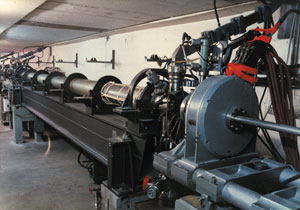The linear accelerator that gave “LAL” at Orsay its name has delivered its last beam, but the laboratory’s involvement with electron linacs remains as strong as ever.

On 19 December 2003 the Laboratoire de l’Accélérateur Linéaire at Orsay marked the final shutdown of its linear accelerator. The event, which was a highly nostalgic occasion, was commemorated by an official ceremony attended by many scientists, engineers and technicians. On 24 December 1958, almost 45 years earlier to the day, the linac had delivered its very first beam, a 3 MeV electron beam. One year later, the first section of the machine achieved an energy of 165 MeV, thus enabling the experiments to begin.
The decision to build a large linear electron accelerator at Orsay was taken in 1955, the year in which land in the Vallée de Chevreuse had been acquired with a view to extending the Faculty of Science in Paris. The specification for the linac and the responsibility for its construction were entrusted to Yves Rocard, head of the physics laboratory of the Ecole Normale Supérieure, and to Hans Halban, head of research in nuclear physics at the laboratory. The CSF (Compagnie générale de télégraphie sans fil) played a major role in the construction. Right from the start, the laboratory housing the machine was named the Laboratoire de l’Accélérateur Linéaire, or LAL for short.
The advantage that a linear accelerator has over circular machines is that its energy can be pushed very high by adding additional sections. The Orsay linac’s energy was gradually increased in this way, reaching 1.3 GeV in 1964 – which for a short time was the world energy record for electron linacs – and 2.3 GeV in 1968. As of 1963, the accelerator was also equipped to deliver a positron beam, whose initial energy of 250 MeV was later increased to 1 GeV.
From the outset the accelerator was also equipped with spectrometers, which became more and more powerful in order to keep up with the linac’s increasing energy. Initially used in electron scattering experiments, whose purpose was to explore the internal structure of many nuclei and of nucleons themselves, they were later refined to allow the study of π-meson photoproduction and electroproduction, and then the photoproduction of K and η mesons. Tests of quantum electrodynamics were also carried out.
The initial goal of the positron beam was to compare these particles’ scattering cross-sections with those of electrons, in order to measure interference between amplitudes involving the exchange of a single and two virtual photons. The positron beam later became a valuable tool in the implementation of collider and storage rings. The Orsay collider ring, ACO, came first, with the first experiment performed in 1967; then the DCI (Dispositif de collisions dans l’igloo), commissioned in 1977; and finally the Super-ACO ring, fully dedicated to the production of synchrotron radiation, with its first experiment in 1988. From 1985 onwards the linac was used exclusively as an injector for the latter two rings. In the case of the DCI, the quality of vacuum achieved through the machine’s 26 years of exploitation – first for particle physics and then as an X-ray source – was such that it was enough to inject particles on Monday mornings for a sufficiently intense beam to be available throughout the following week.
Thus, during its 45 years of operation, the Orsay linac was used, in turn, for nuclear physics, particle physics and as an injector for the synchrotron light sources for LURE (Laboratoire pour l’Utilisation du Rayonnement Electromagnétique). The ceremony on 19 December 2003 marked the shutdown of the beams that were circulating in the DCI and Super ACO, and were being used by scientists at LURE.
Although the Orsay linac has not been used by the particle-physics community at LAL for almost 20 years now, the laboratory is still carrying out R&D and construction in the field of electron linear accelerators. In partnership with CERN, it designed and built the electron and positron injector, LIL, for LEP in the 1980s. Today, LAL is heavily involved in a study and test programme concerning the power couplers that will supply the superconducting cavities in the framework of the TESLA collaboration; it is also responsible for the electron gun and the pre-buncher cavities of the CTF3 (CLIC test facility) prototype at CERN. Thanks to this activity and the laboratory’s ambition to take part in the construction of a future linear collider, which it is hoped will be undertaken by a worldwide collaboration, LAL continues to be an appropriate name for the laboratory, even if the accelerator from which it derives has now been closed down.







